 Rules of the game: Reversi.
Rules of the game: Reversi.
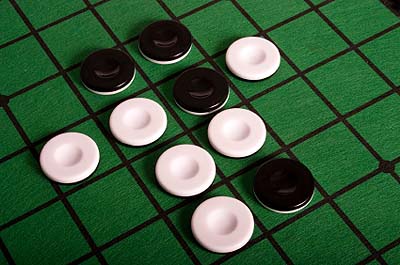
 Rules of the game: Reversi.
Rules of the game: Reversi.

The game Reversi is a game of strategy where you try to possess the biggest territory possible.
To play, just click the area where to place your pawn.
Remember you can set the clock parameters in the game options.
Each player takes 32 discs and chooses one colour to use throughout the game.
Black places two black discs and White places two white discs as shown in Figure 1. The game always begins with this setup.
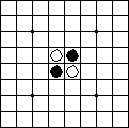 Figure 1
Figure 1
A move consists of "outflanking" your opponent's disc(s), then flipping the outflanked disc(s) to your colour.
To outflank means to place a disc on the board so that your opponent's row (or rows) of disc(s) is bordered at each end by a disc of your colour. (A "row" may be made up of one or more discs).
Here's one example: White disc A was already in place on the board. The placement of white disc B outflanks the row of three black discs.

White flips the outflanked discs and now the row looks like this:

2. If on your turn you cannot outflank and flip at least one opposing disc, your turn is forfeited and your opponent moves again. However, if a move is available to you, you may not forfeit your turn.
3. A disc may outflank any number of discs in one or more rows in any number of directions at the same time - horizontally, vertically or diagonally. (A row is defined as one or more discs in a continuous straight line ). See Figures 2 and 3.
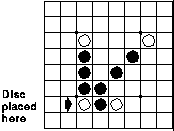 Figure 2
Figure 2 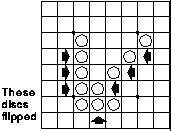 Figure
3
Figure
3
4. You may not skip over your own colour disc to outflank an opposing disc. (See Figure 4).
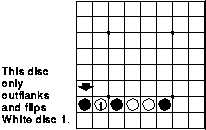 Figure 4
Figure 4
5. Discs may only be outflanked as a direct result of a move and must fall in the direct line of the disc placed down. (See Figure 5 and 6).
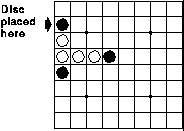 Figure 5
Figure 5 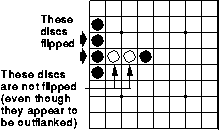 Figure
6
Figure
6
6. All discs outflanked in any one move must be flipped, even if it is to the player's advantage not to flip them at all.
7. A player who flips a disc which should not have been turned may correct the mistake as long as the opponent has not made a subsequent move. If the opponent has already moved, it is too late to change and the disc(s) remain as is.
8. Once a disc is placed on a square, it can never be moved to another square later in the game.
9. If a player runs out of discs, but still has an opportunity to outflank an opposing disc on his or her turn, the opponent must give the player a disc to use. (This can happen as many times as the player needs and can use a disc).
10. When it is no longer possible for either player to move, the game is over. Discs are counted and the player with the majority of his or her colour discs on the board is the winner.
NOTE: It is possible for a game to end before all 64 squares are filled.